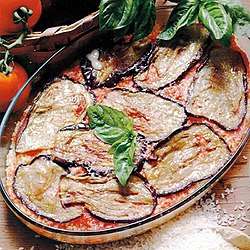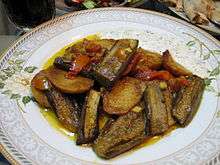Parmigiana
 Melanzane alla Parmigiana | |
| Place of origin | Italy |
|---|---|
| Region or state | Campania, Sicily, Parma |
| Main ingredients | Eggplant or breaded meat, cheese, tomato sauce |
| Variations | Veal, Chicken |
Parmigiana (/ˌpɑːrmɪˈdʒɑːnə,
Preparation
The dish consists of sliced eggplant, pan fried in oil, layered with tomato sauce and cheese, and baked in an oven. In some versions, the sliced filling is first dipped in beaten eggs and dredged in flour or breadcrumbs before frying. Some recipes use hard grated cheeses such as Parmigiano, while others use softer melting cheeses like mozzarella, or a combination of these.
Italian variations
In Naples Parmigiana is also prepared using zucchini or artichokes in place of aubergines.[2]
International variations
Variations made with breaded meat cutlets, such as veal and chicken, have been popularized in other countries, usually in areas of Italian immigration.
In the United States and Canada, veal parmigiana or chicken parmigiana is often served as a main course, and sometimes is served as a submarine sandwich. It is also popular with a side of or on top of pasta. Diced onions or green bell peppers, sauteed or raw, are sometimes added.[3] A similar veal dish is known in Italian as Cotolette alla Bolognese.,[4] however, traditional Italian recipes exclude tomato sauce from the dish. Costolette Parmigiana is another related veal dish, however, in Italy it is generally served without sauce or cheese.[5]
Veal or chicken parmigiana is a common dish in Australia and Argentina and in both countries often served with a side of chips or salad.[6][7] In Australia, it may also contain a variety of toppings, including sliced ham or fried eggplant (aubergine) slices.[8][9]
In Argentina and in other neighboring South American countries, veal or chicken parmigiana is topped with ham and served with french fries. It is known as milanesa a la napolitana.[10][11][12][13] If the dish is topped with a fried egg, then it is known as a súper milanesa or suprema napolitana. The origin of the dish was the Napoli restaurant in Buenos Aires during the 1940s. (See also Milanesa napolitana (in Spanish).)
A similar dish, the parmo, which uses either pork or chicken, has developed in England.
In Brazil, Parmigiana is a popular restaurant dish, which was brought over by Italian immigrants. There are three kinds of Parmigiana in Brazil: filé de frango a parmigiana (chicken fillet parmigiana), berinjela a parmigiana (eggplant parmigiana) and meat parmigiana. Three types of beef are used to make meat parmigiana: two prime cuts, yielding, respectively, filé mignon à parmigiana (tenderloin parmigiana) and contra-filé à parmigiana (sirloin steak parmigiana), while the third type, yielding bife à parmigiana, is simply beef of an unspecified cut. In Brazil, Parmigiana dishes are usually served with either white rice and french fries or with pasta in a tomato sauce.
See also
References
- ↑ "Archived copy" (PDF). Archived from the original (PDF) on 2017-02-14. Retrieved 2017-05-24.
- ↑ Francesconi, Jeanne Caròla (1995) [1965]. La vera cucina di Napoli (in Italian). Roma: Newton Compton Editori. pp. 219–20. ISBN 8881830213.
- ↑ Ostrosky, Marie. "Veal Parmigiana Recipe". Food Network. Retrieved 2014-03-23.
- ↑ Phillips, Kyle (2014-03-03). "Veal Parmigiana Recipe – Cotolette alla Bolognese – Easy Veal Parmigiana Recipe". Italianfood.about.com. Archived from the original on 2014-07-12. Retrieved 2014-03-23.
- ↑ Kaminski, Margot (October 12, 2006). "Fake Accent". Chowhound. Retrieved November 1, 2015.
- ↑ "America's Best Chicken Parm Sandwiches". The Huffington Post. 13 June 2013. Retrieved 14 May 2014.
- ↑ Pisarro, Marcelo (2012-05-11). "Milanesa napolitana". Clarín (Argentine newspaper) (in Spanish). Buenos Aires, Argentina.
- ↑ Levin, Darren (2004-08-07). "Keeping abreast of the Parma best". The Age. Melbourne, Victoria. p. A2.2.
- ↑ Peucker, Christie (2011-01-02). "They're the parmi police Duo in quest for Adelaide's best". Sunday Mail. Adelaide, South Australia. p. 20.
- ↑ Pisarro, Marcelo (2012-05-11). "Milanesa napolitana". Clarín (Argentine newspaper) (in Spanish).
- ↑ "Milanesa a la napolitana". El Reporte (in Spanish). 2013-04-25.
- ↑ "El origen de la milanesa". ABC Color (in Spanish). 2013-04-13. Archived from the original on 2014-05-17.
- ↑ Asier, Soren (2012-07-13). "Clásica milanesa napolitana de Argentina". iMujer (in Spanish).
External links

